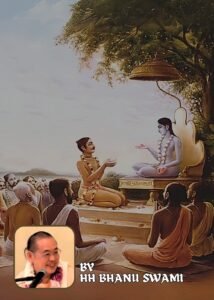ŚB 11.10.4
nivṛttaṁ karma seveta
pravṛttaṁ mat-paras tyajet
jijñāsāyāṁ sampravṛtto
nādriyet karma-codanām
Translation
One who has fixed Me within his mind as the goal of life should give up activities based on sense gratification and should instead execute work governed by the regulative principles for advancement. When, however, one is fully engaged in searching out the ultimate truth of the soul, one should not accept the scriptural injunctions governing fruitive activities.
Purport
Śrīla Viśvanātha Cakravartī Ṭhākura explains that the words jijñāsāyāṁ sampravṛttaḥ refer to one who is yoga-ārūḍha, or advanced in the yoga process. In Bhagavad-gītā (6.3-4) it is stated:
ārurukṣor muner yogaṁ
karma kāraṇam ucyate
yogārūḍhasya tasyaiva
śamaḥ kāraṇam ucyate
yadā hi nendriyārtheṣu
na karmasv anuṣajjate
sarva-saṅkalpa-sannyāsī
yogārūḍhas tadocyate
“For one who is a neophyte in the eightfold yoga system, work is said to be the means; and for one who has already attained to yoga, cessation of all material activities is said to be the means. A person is said to have attained to yoga when, having renounced all material desires, he neither acts for sense gratification nor engages in fruitive activities.” The example may be given that an ordinary man will try to enjoy the company of women for material sense pleasure. This is called pravṛtta-karma, or the path of sense gratification. A religious person will also enjoy the company of a woman, but under the regulative principles of the varṇāśrama system. However, one who is fully absorbed in spiritual advancement will ultimately give up all sense gratification derived from sexual association, either regulated or illicit. Similarly, in the stage of pravṛtta-karma, or ordinary sense gratification, one will eat whatever pleases his tongue. On the other hand, a materialistic devotee will sometimes cook sumptuous preparations and offer them to the Deity, not in order to satisfy the Lord but rather with the intention of satisfying his own tongue and belly. However, one who is sampravṛtta, or fully engaged in spiritual consciousness, is never interested in simply gratifying his tongue. He avoids ordinary foods prepared by materialistic persons, and just for the purpose of keeping his body fit for serving Kṛṣṇa he eats moderate quantities of food that has first been offered to the Deity for the Deity’s pleasure.
The process of spiritual realization gradually brings a conditioned soul from the lowest point of materialistic consciousness to total absorption in loving service to the Personality of Godhead. In the beginning one is taught to dovetail one’s enjoying propensities by first offering to the Lord the fruit of one’s work. In the advanced stage, however, the impulse to execute fruitive activities (karma-codanām) is absent, and one simply engages in the loving service of the Lord without any selfish motive. For example, a renounced sannyāsī preaching Kṛṣṇa consciousness, or even a renounced householder preaching Kṛṣṇa consciousness, is not required to execute all of the injunctions governing sense gratification in family life. Ultimately, every human being should take to the transcendental duties of Kṛṣṇa consciousness. Rather than working to fulfill one’s own desires and then offering the results to Kṛṣṇa, one should fully engage in pleasing the Lord directly according to His own intimate desires.
According to Śrīla Bhaktisiddhānta Sarasvatī Ṭhākura, any attempt to enjoy the material world, either religiously or irreligiously, ultimately will be full of contradictions. One should come to the true platform of desirelessness, pure love of Godhead, and thus solve all of the problems of life.
HH Bhanu Swami Maharaj :
So far the discussion has been of renouncing enjoyment in the material world. Here that renunciation of material enjoyment is first linked with karma yoga or the injunctions of the Veda. So the system of karma yoga, with all of its rules, is often typified as being materialistic. At the same time, it is also an alternative to sense gratification with no rules and regulations. So, satisfying the senses is allowed, but with some restrictions. And the goal is also sense gratification. So through these acts of following Dharma, one elevates oneself and goes to Swarga Loka. So the positive point is that we avoid sin and we avoid falling into lower gunas. The negative point is that we are still stuck in the material world. So because of that goal of being stuck in the material world, it is often condemned.
So the system can be modified. So this is what we call Niskama Karma Yoga. So we do the activities, but we attempt to give up desire for materialistic enjoyable results. So we carry out the same activities of restricted enjoyment, and our desire is not to get a material enjoyment result like Swarga Loka. So this is praised as a superior process to the Sakama Karma Yoga. Because the attachment to sense gratification is less, the goal is not sense gratification. The negative point is that what is the goal is not really defined [Laughs], we are just not attracted to sense gratification. So often the goal will simply be do the duties, etc. But then the other goal may be liberation. So a superior step to this is to offer the results of all of these karmas to Supreme Lord. So that may consist of offering the results of all the duties you do within that system to Krishna. So this is superior, because at least we have a personal goal of Supreme Lord there. And that we find explained in this verse where it says you become detached from your material karmas, at the same time matpara, you are also dedicated to Krishna. So some people may think this is the final goal because we are worshipping Krishna.
However, our Acharyas make a distinction here. Certainly there is a conscious connection with Krishna. But we have a whole other system called Bhakti Yoga, which is different from Karma Yoga. So if we look at all the actions of Bhakti Yoga, they are quite different from the actions in Karma Yoga. So we have activities like Kirtan and hearing Bhagavatam, association with devotees, worshipping the deity. So these activities are directly related to the Supreme Lord. And their goal is to please the Lord. So they are not activities to modify and then connect to the Lord, they are by their nature activities to please the Lord. So we don’t do the activity and afterwards offer it to the Lord. Actually we are doing it for the Lord from the very beginning [Laughs]. So this is much superior to that Niskama Karma Yoga with Karma arpan offering the activities to Krishna. And the goal is also different. The goal of doing Karma Yoga and offering the results to Krishna is still a little vague and often it just leads to promotion to higher planets [Laughs]. However, one good result is that from this stage one can come to the practice of Bhakti Yoga.
But as we know, even Bhakti Yoga may be mixed or pure [Laughs]. And many people come with a mixed Bhakti. So they mix the Bhakti with desires for some material achievements. Still, that is a step higher than the Niskama Karma Yoga offered to Krishna [Laughs]. Because those activities of Bhakti are, as I said, directly related to Krishna. However, the goal that we achieve through that is different from doing pure Bhakti.
So beyond this mixed Bhakti, the next step is pure Bhakti. So it is with pure Bhakti that we can attain Prema. So, in this pure Bhakti, as long as we don’t mix material desires, it is possible for us to perform other processes like Karma Yoga or Jnana or even Yoga. But they always have to remain secondary. If we end up doing 8 hours a day Yoga and 20 minutes Hare Krishna [Laughs], it changes the balance and it is more Yoga and it is less Bhakti. So, in the practice of Bhakti, these other things, things from Jnana, Yoga or Karma may be useful for the devotee, but as secondary processes. And therefore, it doesn’t harm the pure Bhakti. So, in this way, the devotee can use other systems or not use other systems, but the main point is, he should not have other desires.
However, as I mentioned previously, people do have material bodies. And they live in the material body. They live in the material world. And they live with other people. So they have to have some system of rules for regulating their relationships with their body, other people. So therefore, the devotees often follow all of these rules that don’t contradict the principles of Bhakti. So, this is an example of practicing those rules of Karma Yoga but as an assistant to Bhakti, not as something that overshadows the Bhakti. Or they may reach a stage where those rules are not really assisting at all, but they just continue the rules to set an example for other people. So, they are completely detached from those rules of Karma Yoga.
And some devotees may give up everything completely, they just do Bhakti, they don’t follow anything [Laughs]. So, this is called the Nirapeksha devotee by Baladeva Vidyabhusan. And they are generally renunciates. So, they don’t follow any rules of Varna or Ashram, they just do Bhakti. But to do that, one has to be qualified with detachment from the world.
So, if they are not detached, then they have to follow the other process of doing their devotional service and also simultaneously doing some aspects of Karma Yoga. But even if he does follow those activities, he should not have any desires for enjoyment for following those Karma Yoga activities. So that is mentioned in the last line of this verse, he doesn’t accept the materialistic aspect of those activities. So, of course, the main principle here is that the person should be dedicated to the Supreme Lord. And the activities of Karma Yoga are there as some sort of assistance only. But without material attachments. So, this is the general principle that the Vaishnavas follow.
Of course, we will find that within the Bhagavatam and other Bhakti scriptures that the emphasis is always put upon the devotional activities. So, the processes of hearing about the Lord and chanting the glories of the Lord are very, very prominent. And often there is no mention of doing anything else [Laughs]. So, this is done because of the great power of hearing and chanting.
Of course, then we see the example of our Acharyas. Some became very renounced, like the Goswamis. So, they just do Bhakti. Then we see others who participated within the Varna Ashrama system but without attachment. And simultaneously they performed their devotional activities. So, we find examples of both of these types of devotees within the line of Caitanya Mahaprabhu. So, both of these types, those who perform pure Bhakti with doing the elements of Karma Yoga without attachment, or the one who just does Bhakti, they are both considered to be practicing pure Bhakti. And not much distinction is made between those two types. We see within Lord Caitanya’s movement, when Lord Caitanya was there, most of them were Grhasthas. But there were a few renounced persons. So, both were there, and one was not considered superior to the other in terms of devotion. So, of course, because socially the Sannyasi is higher, then for that reason he gets special respect. And that is the reason why Lord Caitanya took Sannyas. However, from the point of view of Bhakti, the two are equivalent.
Q & A
1) Maharaj in the purport its mentioned that “working to fulfill one’s own desires and then offering the results to Kṛṣṇa, one should fully engage in pleasing the Lord directly according to His own intimate desires.” Here two types are given one’s own desire, intimate desire how to understand? I understand one’s desire is bodily desire and intimate desire is spiritual desire?
Well… Too contradictory. Its little hard to interpret, but the actual meaning is there…but one meaning could be once we perform devotional service then we may have certain preferences for we emphasize some people may do deity worship, some people may do preaching, some may do chanting, etc. And emphasize that more than other things.
In all these activities, the goal is to establish a personal relationship with the Lord. In other words, the process of Bhakti is not impersonal. We are trying to please the Lord by our activities. So, in that sense, there is intimacy.
2) The Mayavadis mention that ‘Mano Rachna’ – One should be free from all desires. Here also, in the last paragraph, it is mentioned that “one should come to the platform of desirelessness and pure love of Godhead.” So, this desirelessness… because we can’t be desireless. As long as the mind is there, there will be some kind of desires.
The goal of Yoga is Chittavrtti Nirodha, to extinguish all the functions of mind, which means no more desires in your mind. And of course, in Jnana, when you get rid of desires completely, then you enter in Brahman, where there is no desire.
But that isn’t the goal of the devotee. The devotee does not give up desire. So, in Caitanya Caritamrta, it explains that Kama is transformed into Prema. Of course, if one has Prema, one has no material desires. But we have 100% strong desire to serve Krishna. So, from the point of view of material desires, yes, the devotee becomes free of all material desires, but he has this desire to serve Krishna, and that becomes 100% strong.
3) Why a person does other Yoga systems, even though they are doing devotional service, without any material achievements, does that mean that he doesn’t have full faith in Bhakti Yoga?
Is this the case of a person who is doing, what, Karma Yoga, or Yoga, and they may do a little Bhakti Yoga, is that? Why? [Laughs] As I said, there is no problem if the main process is Bhakti, and the other is assistant only.
But, if the other system is more prominent, and the Bhakti is less, then we don’t really call it Bhakti, we can say it is Bhakti mishra Yoga, for instance. It is Yoga with a little Bhakti mix in it. So, there is nothing wrong with that. And in fact, Jnana and Yoga have to have Bhakti in them a little bit, otherwise you can’t even get the result you want from Jnana or Yoga. However, often that Bhakti is used to get liberation. So, it is not pure Bhakti also [Laughs]. So, even in that situation, it is not considered as pure Bhakti.
4) You mentioned about Nirapeksha in the process is it just referring to only sannyasis and babajis are nirapekshas?
Other Avadhutas are also allowed to do this.
5) Again someone is aspiring for pure devotion and at the same time, having a life partner who is also aspiring for pure devotion. So, there is no material in that? A devotee is aspiring for pure devotional service, and he is also about to be married, and he is also looking for a partner who is having the same aspiration. But having a woman or a man as a life partner with pure devotion as a motive, is there any material motive in that by any chance?
So, this is the conduct of a person who is not qualified to be Nirapeksha. So, he is not qualified to renounce everything. So, therefore, it is approved that he should get married and follow the rules for married life, etc., according to Varnashrama principles. And at the same time, he never gives up his practice of Bhakti. Nor does he make the Bhakti subservient to the Karma Yoga aspect.
6) Should one perform Karma only as an example to others? Why can’t we perform pure Bhakti without Karma, as an example for others?
Then one becomes Nirapeksha. You have to give up your wife and children and everything [Laughs]. Because otherwise, if you have a wife and child, then you have to follow some rules.
7) What is recression for a devotee Maharaj?
I don’t know if he has clearly discussed this anywhere. [Laughs].
8) Dandavat pranam Maharaj, Hare Krishna, what are the regulations of Brahma Madhya Sampradaya?
Well we can say first this is Lord Caitanya’s sampardaya. So, following the teachings of Chaitanya Mahaprabhu, Nama Sankirtana is most prominent as a sadhana, and we follow the theology of the Goswamis. So, following the teachings of Nama Sankirtana, we follow the theology of the Goswamis.
9) Hare Krishna Maharaj. Maharaj, a devotee keeps practising suddha bhakti, attains prema, what is the secret essence behind this…like what is that improvising because the practice is same but after sometime he attains prema what is the essential thing?
Well, two things. One is to follow the process correctly, and the other is to get the mercy of the devotees.
10) Chanting and hearing seems to be the most simple process. As a result, because it is so simple, people don’t take so much faith in it… general mass.
Well, to help us get faith, therefore, we find the Bhagavatam gives great emphasis to this. In fact, if you go to the first canto, you’ll find that’s the main emphasis. So, our faith should be based on scripture. And we go to the scripture, then we’ll see that… hearing and chanting.
11) Hare Krishna Maharaj, apart from chanting, like asking, please engage me in your devotional service, in case if I’m… I’m not asking for material desire, so what should I ask for? Sometimes I ask Krishna, engage me in pure devotional service, and other time, you know very well that you should give me. Then what should be the core of my prayer?
So, the main thing is we desire to please Krishna, whatever we do.
Devotees: Grantharaj Srimad Bhagavatham ki jai!!! HH Bhanu Swami Maharaj ki jai!!!


